How Do Women Overcome Gender Inequality by Forming Small-Scale Cooperatives? The Case of the Agricultural Sector in Uganda
Abstract
1. Introduction
2. Theoretical Background
2.1. Gendering
2.2. Business Relationship in the Informal Economy
2.3. Business Relationships and Gendering in the Ugandan Informal Economy
3. Methodology
3.1. Research Context
3.2. Research Design
3.3. Data Collection
3.4. Data Analysis
4. Findings
4.1. Theme 1: Business Relationship Development in the Agricultural Sector in Uganda
4.1.1. Inter-Organization Business Relationships and Intra-Organization Business Relationships
“Now farming, being a household affair, it means that everybody [every family member] is involved at some stage or another.”(Catherine Tindiwensi)
4.1.2. Informal Business Relationship Development
“So how the relations develop, they are informal, but what happens is that the Kampala traders first come, and when they come, they first exchange contacts, so once the season comes, either these ones call them and say I have buns of rice or the other way around. You have rice, then the relationship can go from there.”(Translated by Catherine Tindiwensi)
4.1.3. Requirements for Inter-Organization Business Relationship Development
“What we do is, first we create an environment between us and the customer. So we make sure that the product we have at least is genuine. So when the customer knows your product is genuine or it works, he does what? He comes back and tells others and brings them towards you. So this is how you create a relationship.”
“One thing is that a seller has liberty, has freedom to choose who he wants to sell to. And therefore, he sells to the person he trusts most. He sells to the person who he thinks will give him better money. He sells to somebody who he thinks is transparent. So overall there is transparency between a seller and a buyer.”
“When women go out of the network they are likely to interact with more men than women, and that could also bring suspicion amongst the spouses.”(Catherine Tindiwensi)
4.1.4. Economic Benefits of Inter-Organization Business Relationship
4.2. Theme 2: Gendering in the Agricultural Sector in Uganda and Effects of Gendering on Inter-Organization and Intra-Organization Relationship Development
4.2.1. Gender Separation
“But also like I mentioned the social, cultural values and expectations of women regarding mobility. Generally a good wife should be like home-based, not too mobile, not too aggressive, those are just societal expectations, but which reflect and impact on how women transact their businesses and network.”
4.2.2. Inter-Organization Relationship Development Is Mostly Undertaken by Men
“But at the end of the day, they [the women] end up being the biggest contributors to farming. Females are by far the biggest contributors to farming. Most of the farming you are seeing is being carried out by women, more than 60% of the work I think. And the male will only be about 40%.”(Nelson, district leader)
“So if you look at farmer organizations as a farm, then they [the women] have like intra-firm relations, intra, within their group. They are stronger at intra-farm relations, or intra-firm relations. Women tend to be closer to home […].”
4.2.3. Intra-Organization Relationship Development Is Mostly Undertaken by Women
4.2.4. Small-Scale Cooperatives by Female Farmers
“[…] they’ve [the women] been facing challenge of education or money, income. So they started this group in order to facilitate them in saving and borrowing money.”
“Women sit on the ground. They shake hands while being on their knees. However, men also sit on the ground”(Adyegi Women Health Network, observational note, 12 April 2017).
“So imagine, with that kind of approach, and if people can access money, people have better chances, people have jobs, people have high income, the calamity of criminal cases and all that would be reduced as well as gender violence, because we are known for that as well, the gender violence in the homes: men battering women and women battering men. So, I imagine if each one of them has income, because we encourage both women groups and men, once the woman has an income the man will relax a bit, because they don’t always have to ask for money from their husband.”
“Remarkable situation: only a woman was able to speak in English and translated almost the entire interview from the locale language to English, and the question about gender was answered first by a loud applause from the interviewees.”(Loro Note En Teko Co-Operative, observational notes, 12 April 2017)
“Women take the lead in improving the quality. They are the ones who clean. So, they are fully involved in practical post-harvest handling and trainings. And we are also promoting them even to market on the marketing committee, electing them on those marketing committees. We give them power. […]Today we are promoting that, empowering them, both from production to marketing.”
5. Theory Development: How Does Gendering Influence Business Relationship Development by Female Farmers in Uganda?
5.1. Gendering, Informal Economy, and Inter-Organization Business Relationship Development in Uganda
5.2. Gendering, Informal Economies, and Intra-Organization Business Relationship Development in Uganda
5.3. Small-Scale Cooperatives as a Means to Achieve Empowerment and Economic Benefits
6. Discussions and Policy Implications
7. Limitations, Avenues for Future Research, and Conclusions
Author Contributions
Funding
Institutional Review Board Statement
Informed Consent Statement
Data Availability Statement
Conflicts of Interest
Appendix A
| Interview guides for women within explicit organizations |
| Introduction |
| 1. Could you introduce yourself? |
| 2. What is your profession? |
| Relationships |
| 3. What is your position within the business? |
| 4. Could you elaborate on with which actors you collaborate/have to deal with? |
| a. With whom do you have to work within the organization? |
| b. With whom do you have to work outside of the organization? |
| c. Why do you need to work with these particular actors? |
| d. Which actors depend on your work? |
| 5. How do you perceive your relationships with others? |
| 6. Could you describe how you develop relationships with other actors? |
| 7. Do you experience any difficulties while developing these relationships? |
| a. If yes, could you describe these difficulties? |
| b. What do you see as the cause of these difficulties? |
| c. And why do you believe that this is the cause? |
| 8. Are there any facilitating factors for developing relationships? |
| a. If yes, could you describe these factors? |
| b. What do you see as the cause of these factors? |
| c. Why do you believe that this is the cause? |
| 9. Could you describe what the goal is of the relationships you develop? |
| Gender |
| 10. What makes your life difficult? |
| 11. To what extent is that based on you being a woman? |
| 12. Could you describe how being a woman affects your work? |
| 13. Could you describe how being a woman affects building relationships within the |
| value chain? |
| Closing of the interview |
| 14. Thank you very much for your time and participation. Do you have any further |
| questions or comments? |
| Interview guides for women on the market |
| Introduction |
| 1. Could you introduce yourself? |
| 2. What is it what you do daily? |
| Relationships |
| 1. Could you explain what you do on the market? |
| 2. Could you elaborate on with which actors you collaborate/have to deal with? |
| a. With whom do you have to work? |
| b. Which actors depend on you? |
| c. Why do you need to work with these particular actors? |
| 3. How do you perceive your relationships with others? |
| 4. Could you describe how you develop relationships with other actors? |
| 5. Do you experience any difficulties while developing these relationships? |
| a. If yes, could you describe these difficulties? |
| b. What do you see as the cause of these difficulties? |
| c. And why do you believe that this is the cause? |
| 6. Are there any facilitating factors for developing relationships? |
| a. If yes, could you describe these factors? |
| b. What do you see as the cause of these factors? |
| c. Why do you believe that this is the cause? |
| 7. Could you describe what the goal is of the relationships you develop? |
| Gender |
| 8. What makes your life difficult? |
| 9. To what extent is that based on you being a woman? |
| 10. Could you describe how being a woman affects your work? |
| 11. Could you describe how being a woman affects building relationships within the |
| value chain? |
| Closing of the interview |
| 12. Thank you very much for your time and participation. Do you have any further |
| questions or comments? |
| Interview guide for NGOs and other institutions |
| Introduction |
| 1. Could you introduce yourself? |
| 2. Could you briefly explain what your position is? |
| Relationships |
| 3. Within the agriculture, what types of relationships between actors exist? |
| 4. How do these relationships develop? |
| 5. Could you describe any difficulties that arise while developing such relationships? |
| 6. Could you describe what factors facilitate relationship development? |
| Gender |
| 7. To what extent are relationships affected by gender? |
| 8. Could you describe how being a woman affects the development of relationships |
| within the value chain? |
| Closing of the interview |
| 9. Thank you very much for your time and participation. Do you have any further |
| questions or comments? |
References
- Ellis, A.; Claire, M.; Blackden, M. Gender and Economic Growth in Uganda: Unleashing the Power of Women; The World Bank: Washington, DC, USA, 2006. [Google Scholar]
- Meier zu Selhausen, F. What determines women’s participation in collective action? Evidence from a western Ugandan coffee cooperative. Fem. Econ. 2016, 22, 130–157. [Google Scholar] [CrossRef]
- Karakire Guma, P. Business in the urban informal economy: Barriers to women’s entrepreneurship in Uganda. J. Afr. Bus. 2015, 16, 305–321. [Google Scholar] [CrossRef]
- Scott, J.W. Gender: Still a useful category of analysis? Diogenes 2010, 57, 7–14. [Google Scholar] [CrossRef]
- Van den Brink, M.; Benschop, Y. Gender in academic networking: The role of gatekeepers in professorial recruitment. J. Manag. Stud. 2014, 51, 460–492. [Google Scholar] [CrossRef]
- West, C.; Zimmerman, D.H. Doing gender. Gend. Soc. 1987, 1, 125–151. [Google Scholar] [CrossRef]
- Nentwich, J.C.; Kelan, E.K. Towards a topology of ‘doing gender’: An analysis of empirical research and its challenges. Gend. Work Organ. 2014, 21, 121–134. [Google Scholar] [CrossRef]
- Martin, P.Y. “Said and done” versus “saying and doing” gendering practices, practicing gender at work. Gend. Soc. 2003, 17, 342–366. [Google Scholar] [CrossRef]
- Martin, P.Y. Practising gender at work: Further thoughts on reflexivity. Gend. Work Organ. 2006, 13, 254–276. [Google Scholar] [CrossRef]
- Fisher, M.S. Wall Street Women; Duke University Press: Durham, NC, USA, 2012. [Google Scholar]
- Burke, W.J.; Li, S.; Banda, D. Female access to fertile land and other inputs in Zambia: Why women get lower yields. Agric. Hum. Values 2018, 35, 761–775. [Google Scholar] [CrossRef]
- David, S.; Kirkby, R.; Kasozi, S. Assessing the impact of bush bean varieties on poverty reduction in sub-Saharan Africa: Evidence from Uganda. Int. Cent. Trop. Agric. 2000, 31. [Google Scholar]
- Glazebrook, T.; Opoku, E. Gender and Sustainability: Learning from Women’s Farming in Africa. Sustainability 2020, 12, 10483. [Google Scholar] [CrossRef]
- Duflo, E. Women empowerment and economic development. J. Econ. Lit. 2012, 50, 1051–1079. [Google Scholar] [CrossRef]
- Ambler, K.; Jones, K.; O’Sullivan, M. Facilitating women’s access to an economic empowerment initiative: Evidence from Uganda. World Dev. 2021, 138, 105224. [Google Scholar] [CrossRef]
- Dyer, J.H.; Singh, H. The relational view: Cooperative strategy and sources of interorganizational competitive advantage. Acad. Manag. Rev. 1998, 23, 660–679. [Google Scholar] [CrossRef]
- Gnyawali, D.R.; Madhavan, R. Cooperative networks and competitive dynamics: A structural embeddedness perspective. Acad. Manag. Rev. 2001, 26, 431–445. [Google Scholar] [CrossRef]
- Portes, A.; Haller, W. The Informal Economy. In The Handbook of Economic Sociology; Princeton University Press: Princeton, NJ, USA, 2010; pp. 403–425. [Google Scholar]
- Berger, L.; Benschop, Y.; Brink, M. Practising Gender When Networking: The Case of University–Industry Innovation Projects. Gend. Work Organ. 2015, 22, 556–578. [Google Scholar] [CrossRef]
- Holgersson, C. Recruiting managing directors: Doing homosociality. Gend. Work Organ. 2013, 20, 454–466. [Google Scholar] [CrossRef]
- Blades, D.; Ferreira, F.H.; Lugo, M.A. The informal economy in developing countries: An introduction. Rev. Income Wealth 2011, 57, S1–S7. [Google Scholar] [CrossRef]
- Myers, M.D. Qualitative Research in Business and Management; Sage Publications Limited: London, UK, 2019. [Google Scholar]
- Buvinić, M.; O’Donnell, M. Gender matters in economic empowerment interventions: A research review. World Bank Res. Obs. 2019, 34, 309–346. [Google Scholar] [CrossRef]
- Peterman, A.; Quisumbing, A.; Behrman, J.; Nkonya, E. Understanding the complexities surrounding gender differences in agricultural productivity in Nigeria and Uganda. J. Dev. Stud. 2011, 47, 1482–1509. [Google Scholar] [CrossRef]
- Pandolfelli, L.; Meinzen-Dick, R.; Dohrn, S. Gender and Collective Action: Motivations, Effectiveness and Impact. J. Int. Dev. 2008, 20, 1–11. [Google Scholar] [CrossRef]
- Alkire, S.; Meinzen-Dick, R.; Peterman, A.; Quisumbing, A.; Seymour, G.; Vaz, A. The women’s empowerment in agriculture index. World Dev. 2013, 52, 71–91. [Google Scholar] [CrossRef]
- Spring, A. African women in the entrepreneurial landscape: Reconsidering the formal and informal sectors. J. Afr. Bus. 2009, 10, 11–30. [Google Scholar] [CrossRef]
- Charmes, J. The informal economy worldwide: Trends and characteristics. Margin J. Appl. Econ. Res. 2012, 6, 103–132. [Google Scholar] [CrossRef]
- Granovetter, M. Economic action and social structure: The problem of embeddedness. Am. J. Sociol. 1985, 91, 481–510. [Google Scholar] [CrossRef]
- Johannisson, B.; Ramírez-Pasillas, M.; Karlsson, G. The institutional embeddedness of local inter-firm networks: A leverage for business creation. Entrep. Reg. Dev. 2002, 14, 297–315. [Google Scholar] [CrossRef]
- Cousins, P.D.; Menguc, B. The implications of socialization and integration in supply chain management. J. Oper. Manag. 2006, 24, 604–620. [Google Scholar] [CrossRef]
- Kabeer, N. Resources, agency, achievements: Reflections on the measurement of women’s empowerment. Dev. Chang. 1999, 30, 435–464. [Google Scholar] [CrossRef]
- Grootaert, C.; Van Bastelaer, T. (Eds.) Understanding and Measuring Social Capital: A Multidisciplinary Tool for Practitioners (Volume 1); World Bank Publications: Washington, DC, USA, 2002. [Google Scholar]
- Woolcock, M.; Narayan, D. Social capital: Implications for development theory, research, and policy. World Bank Res. Obs. 2000, 15, 225–249. [Google Scholar] [CrossRef]
- Heikkilä, A.; Kalmi, P.; Ruuskanen, O.P. Social capital and access to credit: Evidence from Uganda. J. Dev. Stud. 2016, 52, 1273–1288. [Google Scholar]
- Aterido, R.; Beck, T.; Iacovone, L. Access to finance in Sub-Saharan Africa: Is there a gender gap? World Dev. 2013, 47, 102–120. [Google Scholar] [CrossRef]
- Glaeser, E.L.; Laibson, D.; Sacerdote, B. An economic approach to social capital. Econ. J. 2002, 112, F437–F458. [Google Scholar] [CrossRef]
- Yusuff, O.S. A theoretical analysis of the concept of informal economy and informality in developing countries. Eur. J. Soc. Sci. 2011, 20, 624–636. [Google Scholar]
- Osunsan, O.K. Gender and performance of small scale enterprises in Kampala, Uganda. Asian J. Soc. Sci. Humanit. 2015, 4, 55–65. [Google Scholar]
- Kikooma, J. Gender and entrepreneurship in Uganda: Women manoeuvring economic space. In Entrepreneurship-Gender, Geographies and Social Context; IntechOpen: London, UK, 2012. [Google Scholar]
- Katungi, E.; Edmeades, S.; Smale, M. Gender, social capital and information exchange in rural Uganda. J. Int. Dev. J. Dev. Stud. Assoc. 2008, 20, 35–52. [Google Scholar] [CrossRef]
- Alderman, H.; Engle, P.; Britto, P.; Siddiqi, A. Longitudinal Evaluation of Uganda Nutrition and Early Childhood Development Project (NECDP); Draft Report; World Bank: Washington, DC, USA, 2003. [Google Scholar]
- Birchall, J. Rediscovering the Co-Operative Advantage: Poverty Reduction through Self-Help; International Labour Organization (ILO): Geneva, Switzerland, 2003. [Google Scholar]
- Markelova, H.; Meinzen-Dick, R.; Hellin, J.; Dohrn, S. Collective Action for Smallholder Market Access. Food Policy 2009, 34, 1–7. [Google Scholar] [CrossRef]
- Quisumbing, A.R.; Pandolfelli, L. Promising Approaches to Address the Needs of Poor Female Farmers: Resources, Constraints, and Interventions. World Dev. 2010, 38, 581–592. [Google Scholar] [CrossRef]
- Datta, P.B.; Gailey, R. Empowering Women through Social Entrepreneurship: Case Study of a Women’s Cooperative in India. Entrep. Theory Pract. 2012, 36, 569–587. [Google Scholar] [CrossRef]
- Majurin, E. How Women Fare in East African Cooperatives: The Case of Kenya, Tanzania and Uganda; ILO: Dar es Salaam, Tanzania, 2012. [Google Scholar]
- Rowley, J. Conducting research interviews. Manag. Res. Rev. 2012, 35, 260–271. [Google Scholar] [CrossRef]
- Edmondson, A.C.; McManus, S.E. Methodological fit in management field research. Acad. Manag. Rev. 2007, 32, 1246–1264. [Google Scholar] [CrossRef]
- Gioia, D.A.; Corley, K.G.; Hamilton, A.L. Seeking qualitative rigor in inductive research: Notes on the Gioia methodology. Organ. Res. Methods 2012, 16, 15–31. [Google Scholar] [CrossRef]
- Locke, K.D. Grounded Theory in Management Research; Sage Publications Limited: London, UK, 2001. [Google Scholar]
- Boyatzis, R.E. Transforming Qualitative Information; SAGE Publications Ltd.: London, UK, 1998. [Google Scholar]
- Corbin, J.; Strauss, A. Strategies for qualitative data analysis. Basics of Qualitative Research. Tech. Proced. Dev. Grounded Theory 2008, 3, 65–86. [Google Scholar]
- Habermas, J. Technology and Science as «Ideology»; Beacon Press: Boston, MA, USA, 1971. [Google Scholar]
- Martin, P.Y.; Turner, B.A. Grounded theory and organizational research. J. Appl. Behav. Sci. 1986, 22, 141–157. [Google Scholar] [CrossRef]
- Akanji, O.O. Micro-finance as a strategy for poverty reduction. Cent. Bank Nigeria Econ. Financ. Rev. 2006, 39, 111–134. [Google Scholar]
- Olomola, A.S. Social Capital, Microfinance Group Performance and Poverty Implications in Nigeria; Nigerian Institute of Social and Economic Research: Ibadan, Nigeria, 2002; pp. 1–25.
- Ong, R. IFC Empower Women by Promoting Entrepreneurship, Job Creation and Growth. Doing Bus. Available online: http://www.ifc.org/ifcext/media.nsf/context/selected/pressrelease? (accessed on 29 December 2020).
- Jones, E.; Smith, S.; Wills, C. Women producers and the benefits of collective forms of enterprise. Gend. Dev. 2012, 20, 13–32. [Google Scholar] [CrossRef]
- Goldstein, M.; Udry, C. The profits of power: Land rights and agricultural investment in Ghana. J. Political Econ. 2008, 116, 981–1022. [Google Scholar] [CrossRef]
- Dasgupta, P. Economics of social capital. Econ. Rec. 2005, 81, S2–S21. [Google Scholar] [CrossRef]
- Maluccio, J.; Haddad, L.; May, J. Social capital and household welfare in South Africa, 1993–1998. J. Dev. Stud. 2000, 36, 54–81. [Google Scholar] [CrossRef]
- Granovetter, M.S. The strength of weak ties. Am. J. Sociol. 1973, 78, 1360–1380. [Google Scholar] [CrossRef]
- Sen, A. The possibility of social choice. Am. Econ. Rev. 1999, 89, 349–378. [Google Scholar] [CrossRef]
- Criado-Gomis, A.; Iniesta-Bonillo, M.A.; Cervera-Taulet, A.; Ribeiro-Soriano, D. Women as Key Agents in Sustainable Entrepreneurship: A Gender Multigroup Analysis of the SEO-Performance Relationship. Sustainability 2020, 12, 1244. [Google Scholar] [CrossRef]
- Chiputwa, B.; Qaim, M. Sustainability standards, gender, and nutrition among smallholder farmers in Uganda. J. Dev. Stud. 2016, 52, 1241–1257. [Google Scholar] [CrossRef]
- Abor, J.; Biekpe, N. How do we explain the capital structure of SMEs in sub-Saharan Africa? J. Econ. Stud. 2009, 36, 83–97. [Google Scholar] [CrossRef]
- Winn, J. Women entrepreneurs: Can we remove the barriers? Int. Entrep. Manag. J. 2005, 1, 381–397. [Google Scholar] [CrossRef]
- Doyle, E.I.; Ward, S.E.; Early, J. The Process of Community Health Education and Promotion; Waveland Press: Long Grove, IL, USA, 2018. [Google Scholar]
- Quisumbing, A.R. Male-female differences in agricultural productivity: Methodological issues and empirical evidence. World Dev. 1996, 24, 1579–1595. [Google Scholar] [CrossRef]
- Birchall, J.; Simmons, R. The involvement of members in the governance of large-scale co-operative and mutual businesses: A formative evaluation of the co-operative group. Rev. Soc. Econ. 2004, 62, 487–515. [Google Scholar] [CrossRef]
- Bruynis, C.L.; Goldsmith, P.D.; Hahn, D.E.; Taylor, W.J. Key success factors for emerging agricultural marketing cooperatives. J. Coop. 2000, 16, 14–24. [Google Scholar]
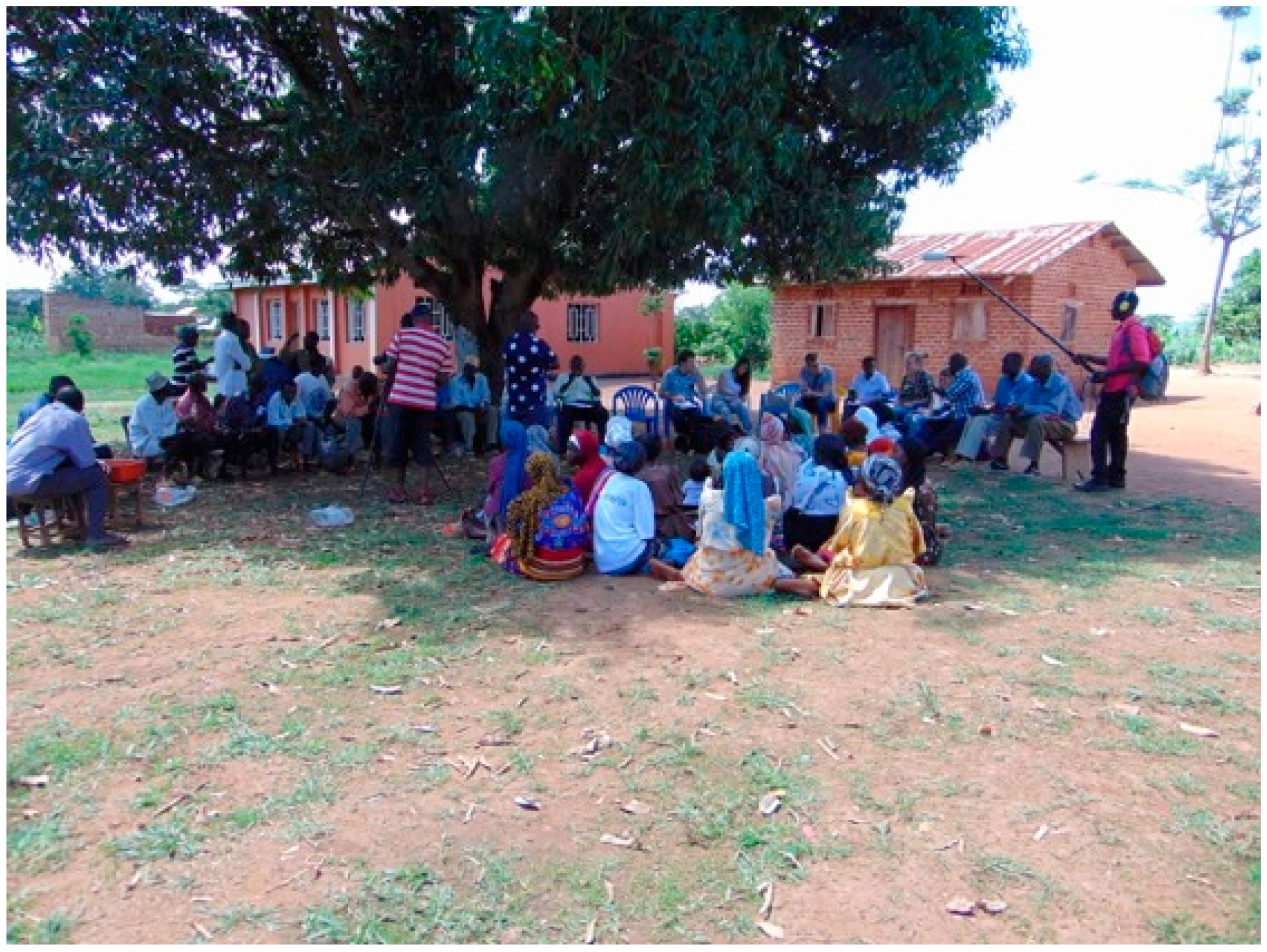
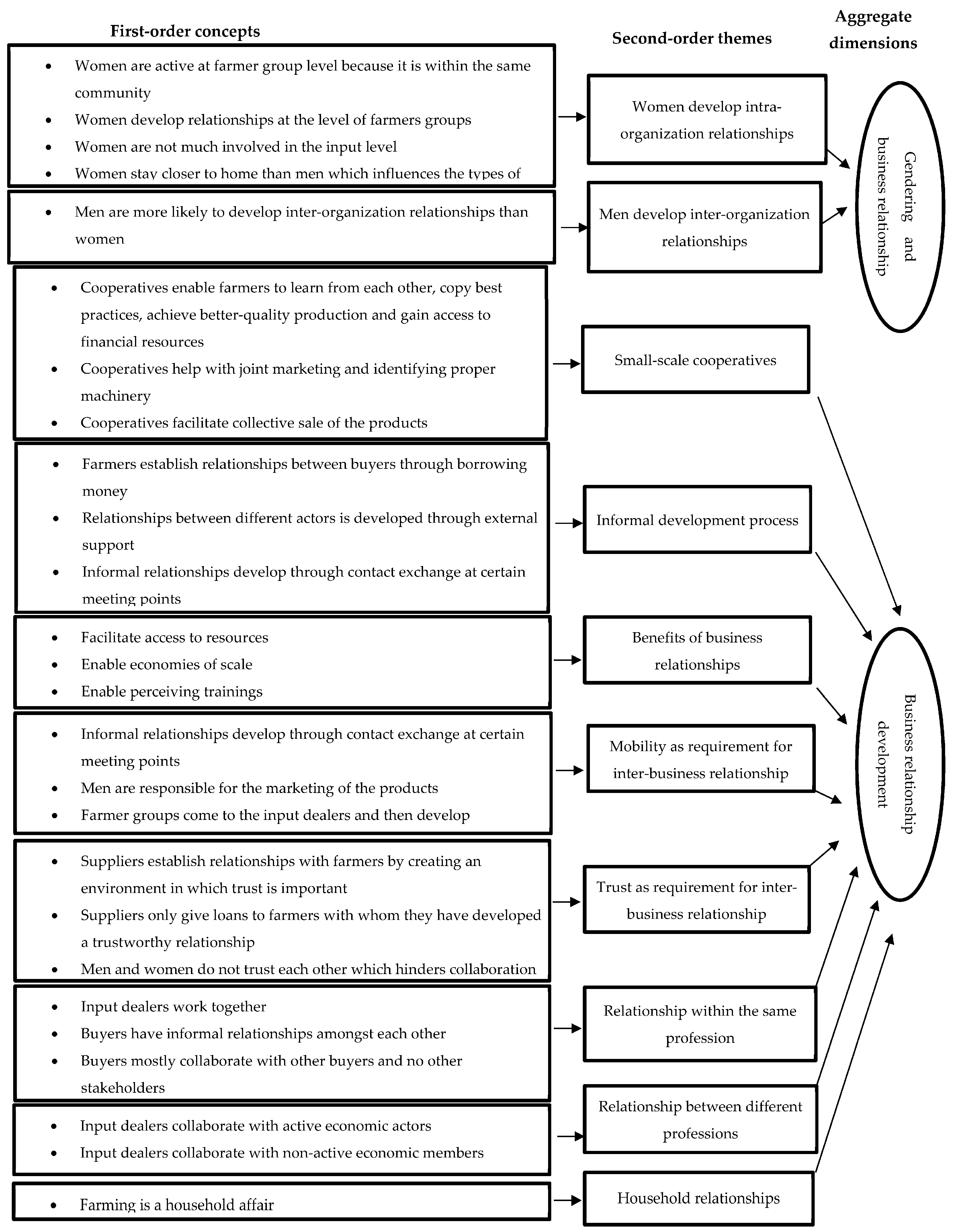
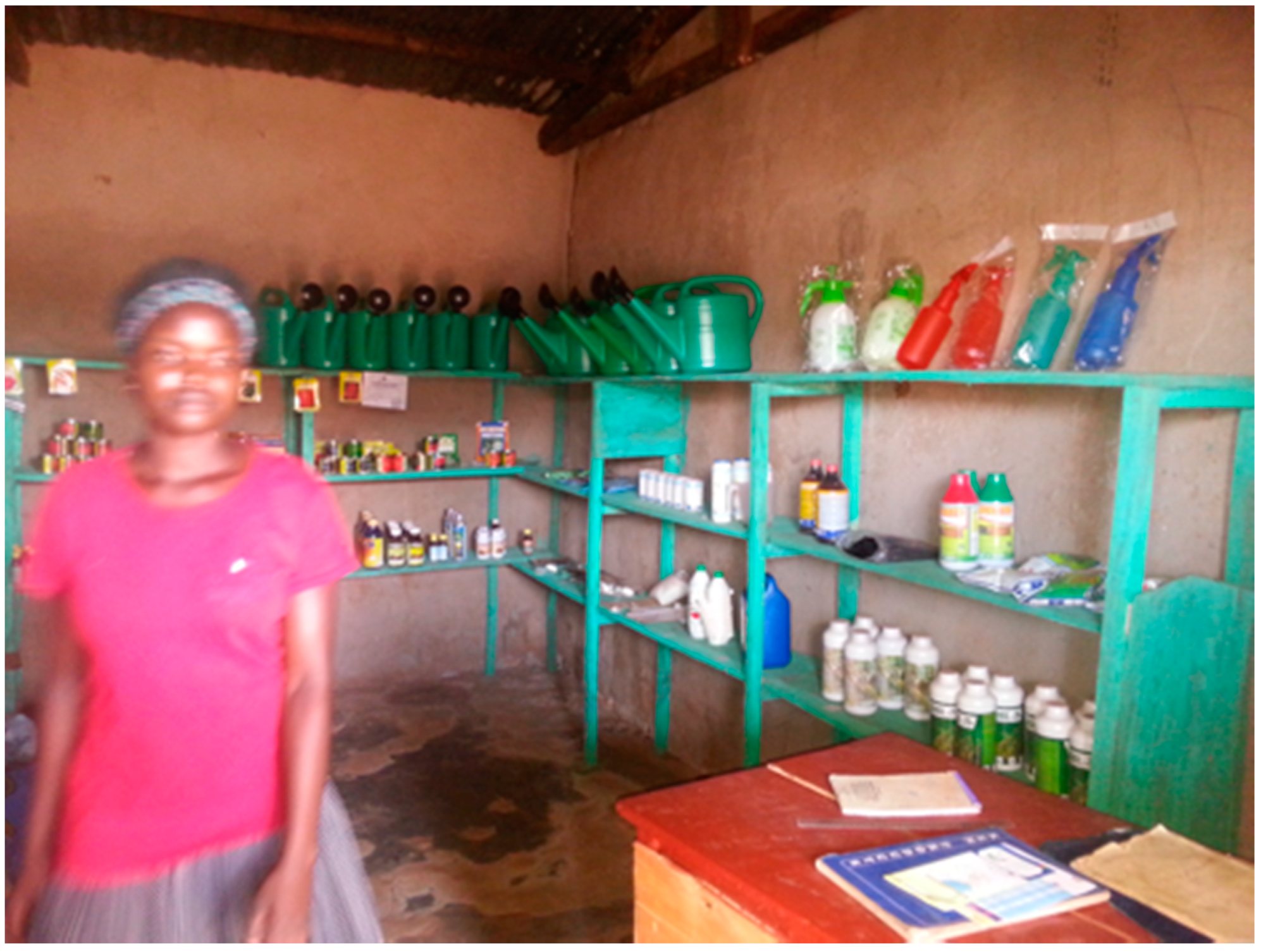
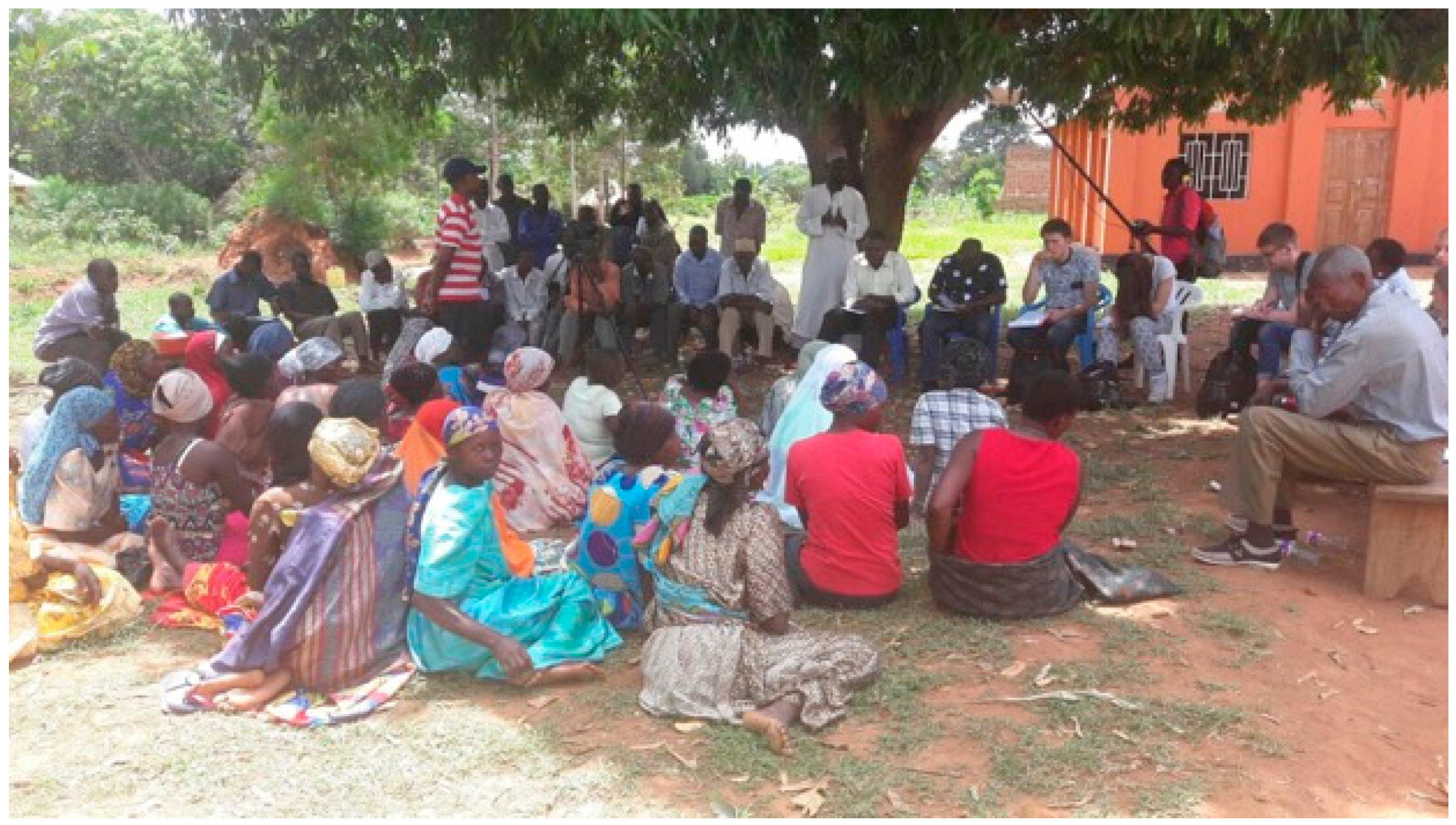
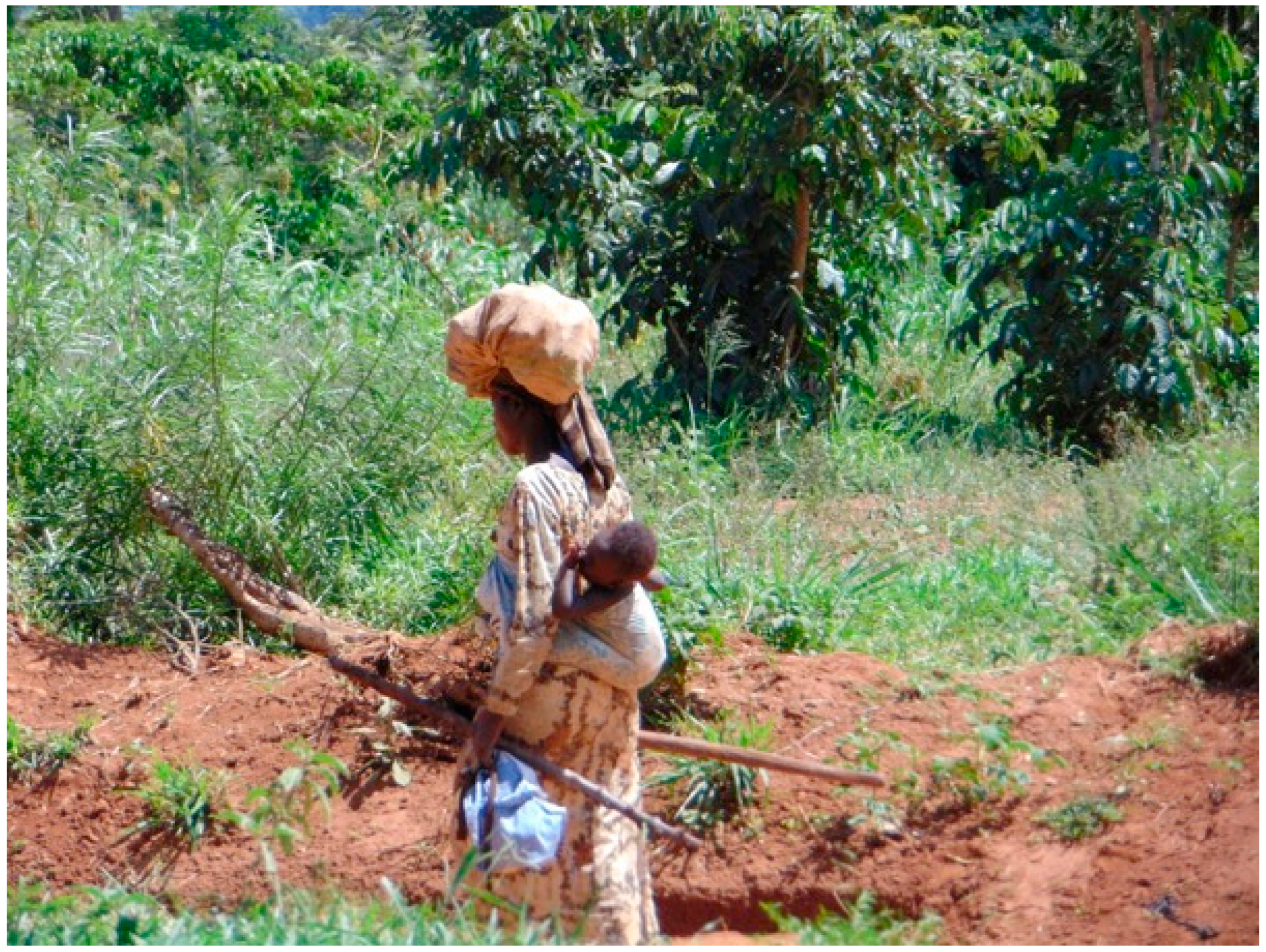
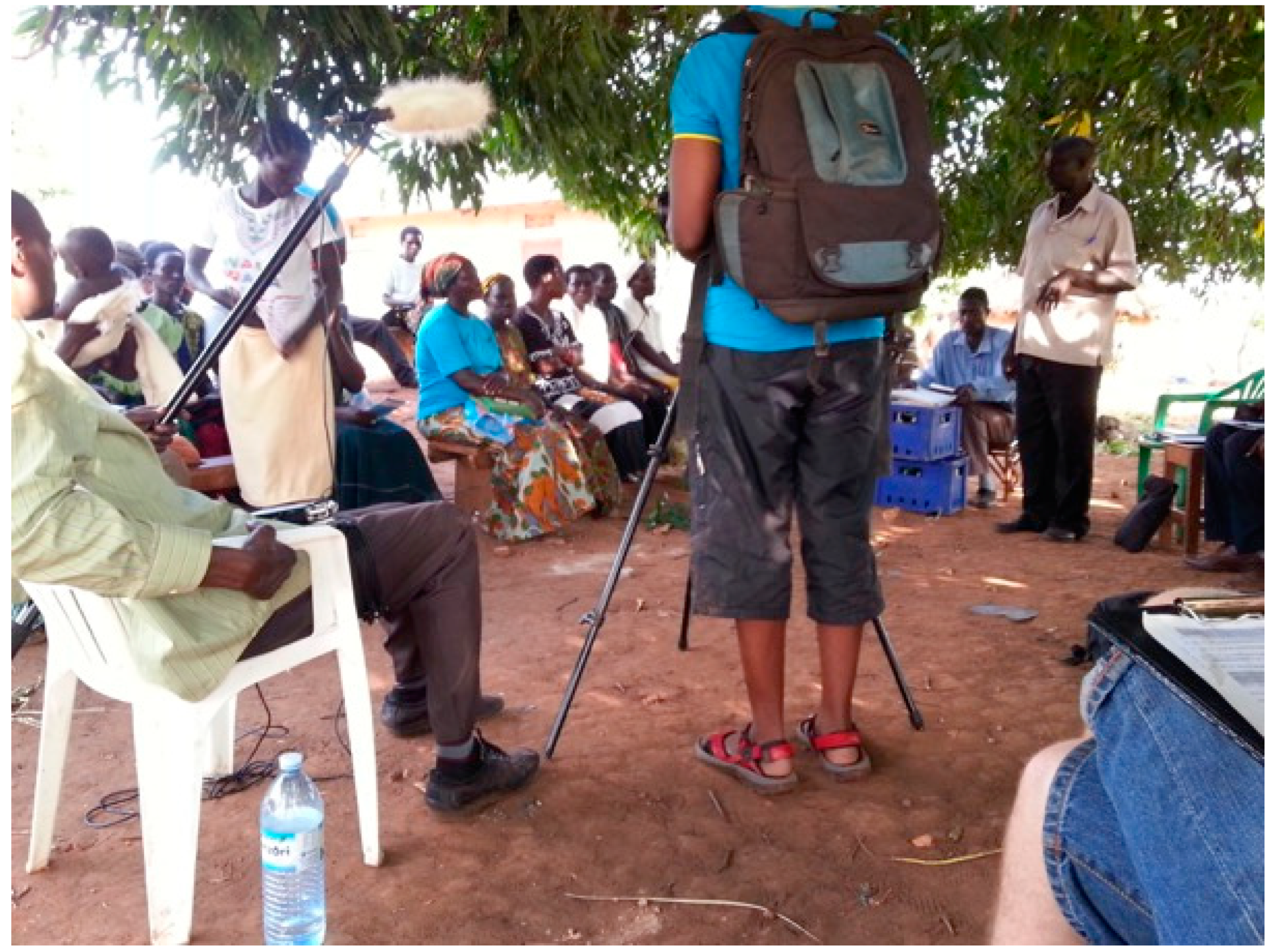
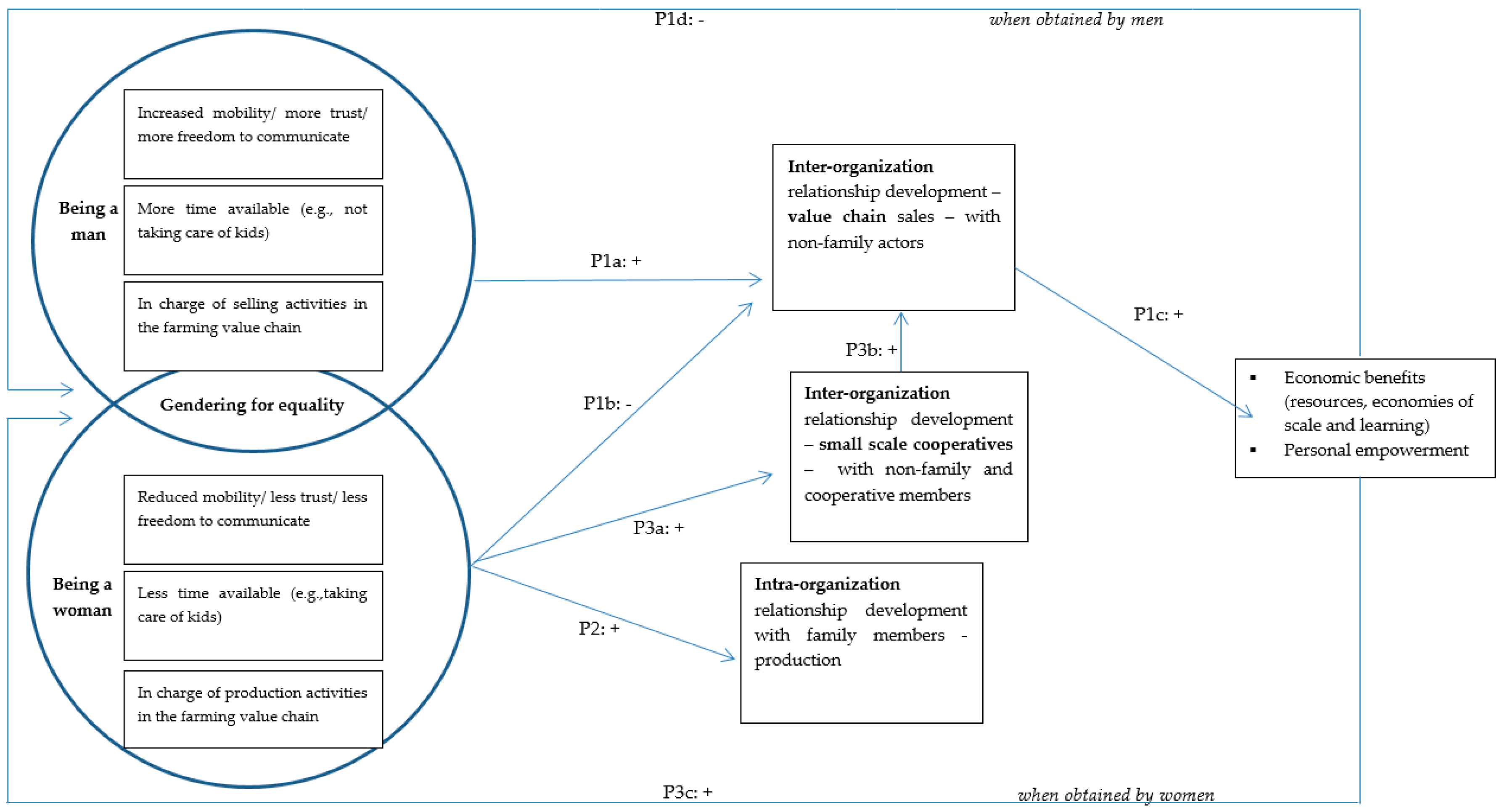
| Data Source | Volume | Details |
|---|---|---|
| Face-to-face interviews | 7 interviews, ranging from 11 min to almost 2 h | 4 interviews in the region Bugiri, 1 of which with a farmer, 2 with input dealers and one with a manager; 2 interviews in the region Oyam with an input dealer and 1 with a researcher; 1 interview with an entrepreneur in Kampala |
| Focus groups | 3 interviews, ranging from 30 min to almost 2 h | 2 interviews in the region Bugiri with members of the district office; 1 interview in the region Oyam with district officer |
| Group conversations | 13 interviews, ranging from 30 min to almost 2 h | 6 interviews in the region Bugiri; 7 interviews in the region Oyam |
| Observational/field notes | 32 pages | Observational and field notes were small notes written down during interviews; observational notes were made during 4 interviews; field notes were made during every interview |
| Photographs | 44 photographs | Selected photographs that illustrated interview settings |
| Factory visit | 1 visit | Visit of factory supported by factory manager in the region Oyam |
| Benefits of Business Relationships | Illustrative Quotes |
|---|---|
| Access to resources (such as economic power, income, and machinery) | “[Farmers working together], for the women, we are now comfortable, because we are always confortable when our husbands are comfortable, [and they are confortable now] because there is an income now.” (Farmer’s Group Umoja, Agali Awamu and Bukyere) |
| Economies of scale | “The advantage [of business relationships] is that they [grouped farmers] produce in bulks and attract more markets, because when you have enough of specific crops, you specialize in one crop and you produce in bulk and then they attract the big market.” (Muhamta Akindora) |
| Learning | “Since we are organized in a group, we were educated about the disadvantages of drying on the ground. The group helped us to be educated and enlightened about this practice.” (Farmer’s groups Umoja, Agali Awamu, Bukyere) |
Publisher’s Note: MDPI stays neutral with regard to jurisdictional claims in published maps and institutional affiliations. |
© 2021 by the authors. Licensee MDPI, Basel, Switzerland. This article is an open access article distributed under the terms and conditions of the Creative Commons Attribution (CC BY) license (http://creativecommons.org/licenses/by/4.0/).
Share and Cite
Theeuwen, A.; Duplat, V.; Wickert, C.; Tjemkes, B. How Do Women Overcome Gender Inequality by Forming Small-Scale Cooperatives? The Case of the Agricultural Sector in Uganda. Sustainability 2021, 13, 1797. https://doi.org/10.3390/su13041797
Theeuwen A, Duplat V, Wickert C, Tjemkes B. How Do Women Overcome Gender Inequality by Forming Small-Scale Cooperatives? The Case of the Agricultural Sector in Uganda. Sustainability. 2021; 13(4):1797. https://doi.org/10.3390/su13041797
Chicago/Turabian StyleTheeuwen, Amber, Valérie Duplat, Christopher Wickert, and Brian Tjemkes. 2021. "How Do Women Overcome Gender Inequality by Forming Small-Scale Cooperatives? The Case of the Agricultural Sector in Uganda" Sustainability 13, no. 4: 1797. https://doi.org/10.3390/su13041797
APA StyleTheeuwen, A., Duplat, V., Wickert, C., & Tjemkes, B. (2021). How Do Women Overcome Gender Inequality by Forming Small-Scale Cooperatives? The Case of the Agricultural Sector in Uganda. Sustainability, 13(4), 1797. https://doi.org/10.3390/su13041797






